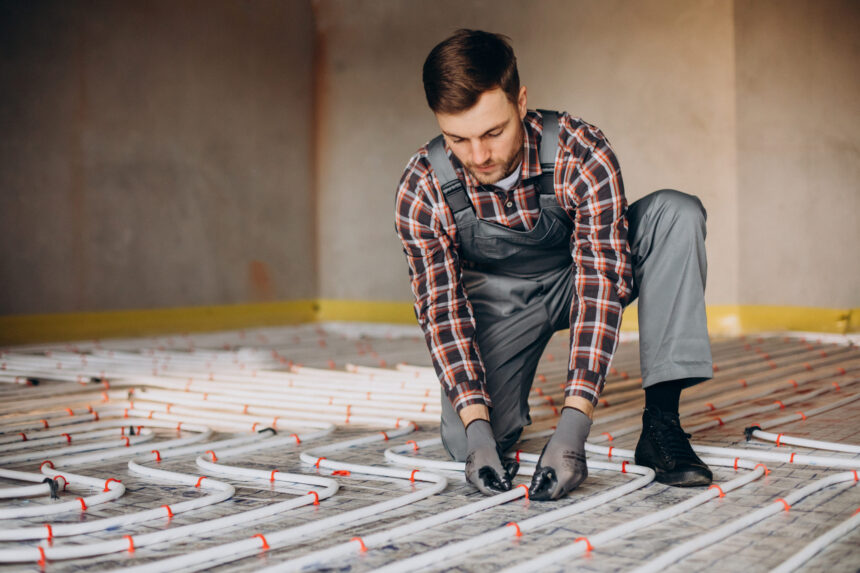Underfloor heating systems are pretty amazing for home comfort. There are two types: electric ones with heating mats and water-based ones with warm water pipes.
People love them because they’re energy-saving and keep your home cosy without those big radiators taking up space.
They’re a top pick for anyone wanting to save money and keep things warm. Just remember, to keep them running smoothly and lasting long, you should check on them regularly. This way, you can avoid any problems and keep enjoying toasty floors.
The Importance of Regular Checks
Keeping an eye on your underfloor heating is super important if you want to avoid any nasty surprises and save some cash over time. Think of it like giving your system a regular check-up. Catching little problems early can stop them from turning into big, expensive ones.
Like, if there’s a tiny leak in a water system and you miss it, it could wreck your floor or mess up the whole setup. And if electric mats wear out, you might not get enough heat, or the system might stop working altogether.
Checklist for Inspections
- Water-based systems: Check for any damp spots or leaks.
- Electric systems: Look for worn-out mats and make sure no wires are sticking out.
- General: Pay attention to weird noises and see if the floor heats unevenly.
Checking things out every 6 to 12 months is a smart move. It helps you spot problems early, keeps your heating running smoothly, and makes your system last longer. This way, you keep your home comfy and avoid unexpected repair bills.
Cleaning Your Underfloor Heating System
Keeping your underfloor heating in tip-top shape is vital for its longevity. If you’ve got a water-based system, flushing the pipes is a must to clear out any gunk that can slow things down. Think of it like giving your system a refreshing cleanse.
Use a power flushing pump that blasts water through the pipes at high speed, clearing out the buildup. Just make sure all the valves are wide open so water can flow smoothly, and keep an eye out for any stubborn blockages that might need a bit more elbow grease.
Afterward, pop in a corrosion inhibitor to help keep those pipes clean and happy for the long haul.
For those with an electric system, keeping dust at bay is the name of the game. Dust can make your system work harder than it needs to and might even cause overheating. A soft brush or a vacuum with a brush attachment is your best friend here.
Gently sweep away dust and debris, but steer clear of wet cloths—moisture and electrics aren’t the best of friends. Giving your heating system a good clean every six months or so will keep it running efficiently and save you from steep energy bills and costly repairs down the line.
So, why not take a moment to check on your underfloor heating? A little bit of TLC now can make all the difference later.
Checking and Replacing Thermostats and Sensors
Keeping your underfloor heating running well often depends on how well the thermostats and sensors are doing their job. If they mess up, your room might not get warm enough or could get too hot, and you’ll see a nasty surprise on your energy bill.
To check if your thermostat’s working, compare how warm it feels with what you expect. For electric setups, a mercury thermometer is handy. If you’ve got a water-based system, go for an infrared one. If things don’t match up, it might be time for a new one.
For checking sensors, a multimeter can help you see if the wires are all good. Programmable thermostats or smart sensors could be a smart buy since they save energy by fitting into your routine. They make things comfy and save money in the long run.
If you’re still stuck after giving it a go, maybe chat with a heating expert.
The Significance of Insulation
Think of insulation like a warm, cosy blanket wrapped around your home. It traps the heat inside, making sure your energy bills don’t go through the roof and your heating system doesn’t work overtime.
When your home is well-insulated, it feels snug, keeping everything humming along nicely, just like a comfy winter jumper.
Checking Existing Insulation
It’s wise to check how your current insulation is holding up. If you notice cold drafts or find that some rooms are chillier than others, there might be some gaps to fill.
You can often spot these issues by wandering around your home, looking for sneaky gaps around windows or doors. But if you want to get a bit techy, a thermal camera can be a real eye-opener for spotting hidden problem areas.
Where to Add Insulation
Consider adding insulation in spots that tend to lose heat quickly, like the edges of rooms and under heating pipes. Old houses or rooms with large windows can be particularly drafty.
Popping some insulation in these places can make your home feel a whole lot more comfortable and cosy. Don’t forget about loft hatches or under floorboards—they’re often overlooked but can make a big difference!
Cost-effective Options
If you’re budgeting, eco-friendly options like recycled denim or sheep’s wool can be fantastic. They not only keep the heat in but are also kind to the environment.
Plus, there might be some government grants or deals available to help you upgrade your insulation. Spending a little now could mean saving a lot on heating bills later. Why not have a look to see what’s out there?
Professional Servicing
Getting your underfloor heating checked by a pro every couple of years is super important to keep it running smoothly. They can spot problems in both electric and water systems that you might miss.
When they come over, they’ll check everything, like the thermostats, and might even suggest some cool upgrades. This way, you keep things working well and avoid spending loads on repairs down the line.
When picking someone to do the job, go for certified folks with good reviews, so you know you’ll get great service. Their know-how is key to sorting out tricky issues, ensuring your place stays cosy without breaking the bank.
Troubleshooting Common Issues
Underfloor heating usually works well, but sometimes you might notice cold spots or weird sounds. Before calling in the pros, you can try a few things yourself.
If one spot’s chilly, check the thermostat first. Still not working? For water-based systems, bleeding might help. Turn off the system, let it cool, and then gently open each radiator valve to let out trapped air.
Weird noises could mean there’s an airlock, and bleeding can fix that. Also, make sure there’s nothing like furniture or closed vents blocking the heat. Sorting out these small issues can bring back the cosy vibes. But if things still aren’t right, you might want to get a professional to take a look.
Conclusion
Keeping your underfloor heating in good shape is a smart move for a warm home and saving money. Give it a check-up now and then, clean it, and swap out old parts like thermostats and sensors.
This keeps things running smoothly and stops big issues before they start. Setting up a maintenance routine helps you remember what needs doing, making sure everything works well and lasts longer.
If things get tricky, calling in a pro can really help—they can spot problems early and suggest improvements. Taking care of your system not only makes it more energy-efficient but also cuts down on future costs. It’s a clever choice for anyone with underfloor heating.


